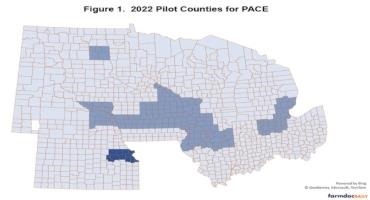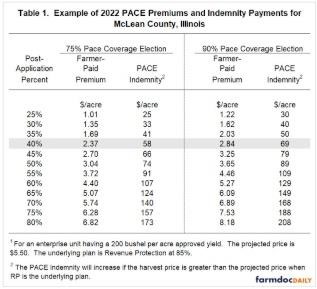
PACE is available if farmers choose to insure their underlying acres with one of the eligible plans of insurance: Revenue Protection (RP), RP with harvest price exclusion, and Yield Protection (YP) eligible plans of insurance. PACE is not available on Area plans of insurance. The farmer must make the decision to add the endorsement by the March 15 sales closing date, the same deadline applicable to the underlying plans of insurance.
The following two variables influence the premium and indemnity payments from PACE:
- Post-Application Percent is the percentage of nitrogen to be applied post-planting. PACE elections range from 25% to 80% in 5% increments. For PACE, a farmer will report the total nitrogen amount expected to be applied, the pre-application percent, and declared post-application percent by March 15th. Suppose a farmer plans to apply 180 pounds of nitrogen, 108 pounds were applied in the fall, and 72 pounds will be applied post-planting. The farmer would report that 180 pounds are expected to be applied, 60% will be applied pre-application (108 / 180), and the declared post-application percent is 40% (72 pounds applied after planting / 180 pounds of N to be applied). PACE premiums will be based on declared post-application percent.
- PACE Coverage Election ranges from 75% to 90% in 5% increments. Higher elections result in higher payments when nitrogen cannot be applied and vice versa. Higher elections also result in higher farmer-paid premiums and vice versa.
The basics of PACE are illustrated for a McLean County, Illinois farm with:
- Approved yield (either the Actual Production History (APH) yield or Trend Adjusted APH yield, depending on whether TA is selected): 200 bushels per acre
- Projected price (will not be known for certain until the end of February): $5.50 per bushel
- Underlying plan: RP at an 85% coverage level
- Unit: Enterprise
- Acres in unit: 100 acres
- Declared post-application percent: 40%
- PACE coverage election: 90%
Premiums and Payments
The PACE indemnity and farmer-paid premium for the example contract are shown in Table 1 for different post-application percentages and 75% and 90% PACE coverage elections, representing the low and high coverage election. For the example (40% post-application percent and a 90% PACE coverage election), the farmer-paid premium is $2.84 per acre. For 100 acres planted, the farmer-paid premium would total $284.

For a 40% post-application percent and 90% coverage election, the PACE indemnity equals $69 per acre (see Table 1). In all instances except for the two discussed below, total PACE indemnity payment will equal the per acre indemnity times the number of acres on which post-application were prevented. For example, if post applications were prevented on 60 acres, the total PACE indemnity payment would be $4,140 ($69 per acre PACE payment x 60 acres).
The PACE indemnity calculated above could be less in two instances. First, the total PACE payment can be limited when the underlying plan of insurance policy pays. When the underlying policy does not make a payment, the PACE indemnity will not be limited. When the underlying policy pays, the PACE indemnity payment is limited to the deductible of the underlying policy. For an 85% coverage level on RP, the deductible is 15% of the guarantee, with the McLean County example guarantee being $1,100 per acre (200 approved yield times $5.50 base price). The RP deductible then is $165 per acre (.15 x $1,100 guarantee). For the 40% post-application rate, the indemnity payment is $69 per acre, below the $165 payment limit. As a result, the underlying policy limit will not come into play. However, the underlying policy limit could impact payments when post-applications percentages are greater than 70% and the 90% PACE coverage level is selected (see Table 1).
Second, the policy checks to make sure the post-application percent is not too high. Payments could be lowered when actual pre-applied nitrogen applications exceed the following quantity:
Approved yield x 1.2 x (1 – declared post-application percent)
When applications exceed the limit, the post-application percent equals:
1 – (actual pre-application / (Approved yield x 1.2))
In the above example, the post-application rate will be lowered if pre-applications exceed 144 pounds (200 approved yield x 1.2 x (1 – .4 declared post-application percent). For example, a 180-pound pre-application would result in a final loss percent of 25% (1 – 180 / (200 x 1.2)).
Insurable Losses
PACE protects against the financial risk of not being able to post-apply nitrogen because of weather related causes of loss that result in the physical inability to post apply the nitrogen. Most likely, nitrogen applications are prevented because of wet weather. PACE does not protect against losses due to equipment failure, scheduling issues, and nitrogen supply issues.
Given normal planting conditions, post-application is expected to occur within a specified window outlined in insurance documents. For McLean County, post-application for corn planted on May 1st are expected to occur between June 1st and June 22nd. In some years, weather may determine if there are variances in the expected windows for post applications that could allow a post-application window to begin on May 29th and end on June 26th.
When a farmer is not able to post-apply nitrogen, that farmer should file a claim with the crop insurance agent. The farmer should expect to provide invoices and receipts for nitrogen applied consistent with their nitrogen plan.
Units
Units do not have to match those of the underlying policy:
- If an enterprise unit is used for the underlying policy, PACE can be used at the enterprise, basic, or optional unit level.
- If basic units are used for the underlying policy, PACE can be used at the basic or optional level
- If optional units are used for the underlying policy, PACE has to be used at the optional unit level.
Not all basic and optional units have to be insured with PACE. One unit could be insured while another is not insured. However, once a unit is chosen to be insured with PACE then all eligible acres within a unit must be insured. Eligible acres are non-irrigated and not classified as high-risk.
PACE is subsidized (see Table 2) like other Federal Crop Insurance policies. Subsidy rates are lower for basic and optional units. As a result, using basic and optional units will increase premiums relative to enterprise units.

PACE Development
PACE was developed under the 508(h) process by Ag-Analytics and University of Illinois researchers. Support came from the AGree Coalition, Meridian Institute, National Corn Growers Association, and Illinois Corn. Sponsoring crop insurance companies were Country Financial and Crop Risk Services.
Summary
PACE allows farmers who are post-applying nitrogen to insure against the possibility that they will be physically unable to post apply the nitrogen due to insurable causes of loss specified within the underlying policy. The policy is a straightforward way to mitigate the financial risk associated with missed applications. As a result, farmers can more effectively apply nitrogen after planting, a practice many believe to be a more effective nitrogen program. The pilot area covers important areas of corn production and is expected to be expanded through time based on experience and usage.
Source : illinois.edu